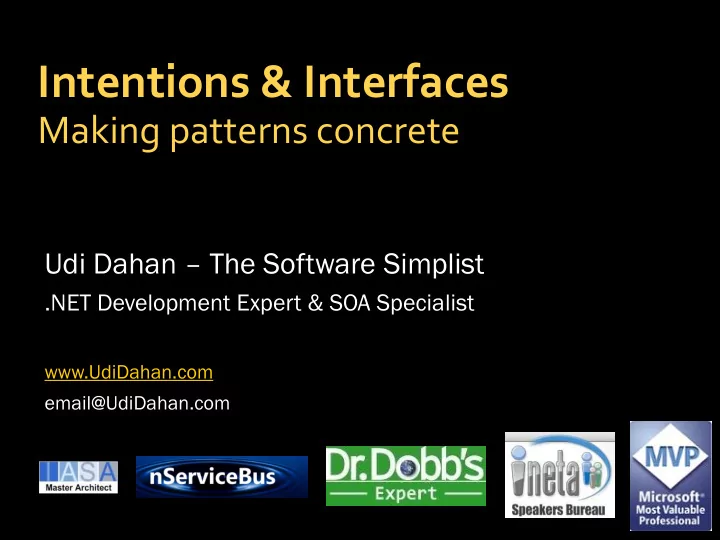

Intentions & Interfaces Making patterns concrete Udi Dahan – The Software Simplist .NET Development Expert & SOA Specialist www.UdiDahan.com email@UdiDahan.com
Books, and books, and books, and books…
Flexibility brings many benefits
Preventing rigidity from creeping in
Existing solutions Strategy Pattern Visitor Pattern
Visitor pattern Requires a method for each ConcreteElement
Strategy pattern Requires all classes to contain a strategy
Applicati lication on Cod ode May cause a collapse of application structure Infrastr In rastructure ucture Code at at Co Co ion io de de lic lic App Infr In fras astructu tructure re Cod ode
Doing too much can hurt ou ren„t onna eed t
“Prediction is very difficult, especially if it's about the future.” -- Niels Bohr Physics Nobel prize 1922
Bolt on flexibility where you need it
Sometimes called “hooks” Applicati lication on Cod ode In Infr frastruc astructure ture Cod ode New New w Code Code Code Code
Flexibility you seek? Hmm? Made your roles explicit, have you? No? That is why you fail.
Make Roles Explicit
Some well known interfaces ISerializable IFather IHusband Java Serializable IGoToWork IComeHome IWashTheDishes
Custom entity validation before persistence
The old “object - oriented” way bool IsValidating; .Validate(); Cust ustomer omer .Validate(); * Address Ad dress .Validate(); Order der But what if we start here? Persis sistenc ence
It looks like our objects have too many roles to play
Make roles explicit
Add a marker interface here, and an interface there…. IEntity where T : IEntity IValidator<T> ValidationError Validate(T entity);
The first part is trivial: IEntity Customer Order
The second part is more interesting IValidator<T> ValidationError Validate(T entity); Customer CustomerValidator: IValidator<Customer> ValidationError Validate(Customer entity);
Add a dash of Inversion of Control Service-Locator style
The extensible way .Persist(Customer) Persis sistenc ence Service vice Lo Loca cator or Get<IValidator<Customer>> new Validate(Customer) Cust stomer omer Val alid idat ator or
But that’s not Object Oriented Is it?
Extensible and Object Oriented .Persist(Customer) Persis sistenc ence Service vice Lo Loca cator or Get<IValidator<Customer>> new Validate(Customer) Cust stomer omer Val alid idat ator or .Validate(); Cust stomer omer
And application code stays simple Applicati lication on Cod ode .Persist(Customer) In Infr frastruc astructure ture Cod ode
Loading objects from the DB public class Customer { public void MakePreferred() { foreach(Order o in this.UnshippedOrders) foreach(Orderline ol in o.OrderLines) ol.Discount(10.Percent); } } Lazy Loading
Dangers of Lazy Loading public void MakePreferred() { foreach(Order o in this.UnshippedOrders) foreach(Orderline ol in o.OrderLines) ol.Discount(10.Percent); } DB
Loading objects from the DB Making a customer Adding an Order “preferred” Customer Customer Order OrderLine
Need Different “Fetching Strategies” public class ServiceLayer { public void MakePreferred(Id customerId) { Customer c = ORM.Get<Customer>(customerId); c.MakePreferred(); } public void AddOrder(Id customerId, OrderInfo o) { Customer c = ORM.Get<Customer>(customerId); c.AddOrder(o); } }
Make Roles Explicit
Use interfaces to differentiate roles IMakeCustomerPreferred IAddOrdersToCustomer void MakePreferred(); void AddOrder(Order o); Customer
Application code specifies role public class ServiceLayer { public void MakePreferred(Id customerId) { IMakeCustomerPreferred c = ORM .Get< IMakeCustomerPreferred>(customerId); c.MakePreferred(); } public void AddOrder(Id customerId, OrderInfo o) { IAddOrdersToCustomer c = ORM .Get< IAddOrdersToCustomer>(customerId); c.AddOrder(o); } }
Extend behavior around role IMakeCustomerPreferred IAddOrdersToCustomer void MakePreferred(); void AddOrder(Order o); Customer T MakeCustomerPreferredFetchingStrategy : Inherits IFetchingStrategy<IMakeCustomerPreferred> string Strategy { get { return “ UnshippedOrders, OrderLines ”; } } IFetchingStrategy<T>
The extensible way .Get<IMakeCustomerPreferred>(id) Persis sistenc ence Service vice Lo Loca cator or Get<IFetchingStrategy< new IMakeCustomerPreferred>> Get strategy MakeCustomerPreferredFetchingStrategy
And the pattern repeats… IMessage where T : IEntity IMessageHandler<T> void Handle(T message);
Once your roles made explicit, you have… Extensibility and flexibility - simple they will be
Thank you Udi Dahan – The Software Simplist .NET Development Expert & SOA Specialist www.UdiDahan.com email@UdiDahan.com
Recommend
More recommend